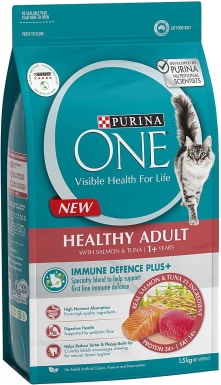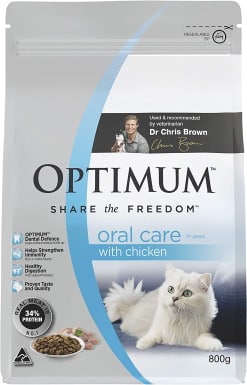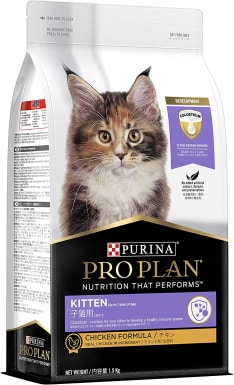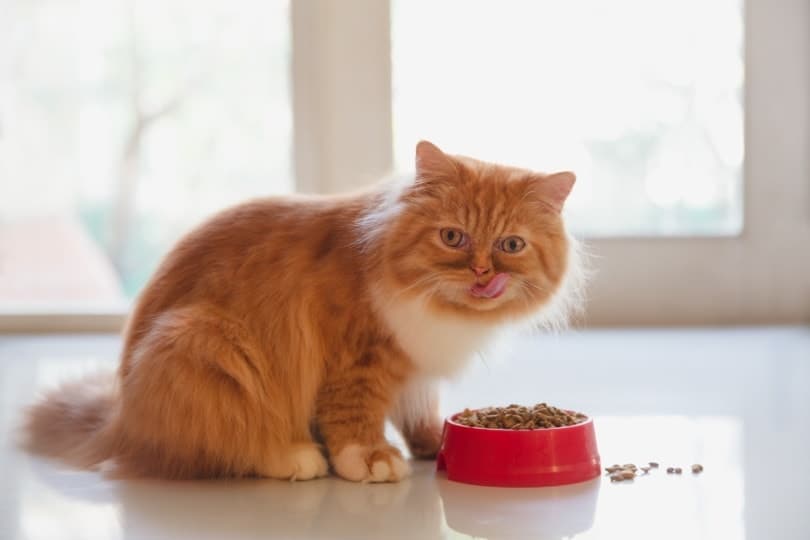
Choosing the right food for your cat is one of the best ways to ensure your kitty’s health and longevity. It can be confusing to pick a cat food with so many brands, and many of them use marketing ploys and fancy packaging to catch your attention.
How can you know you’re choosing the right food for your cat? To help you select the best food for your cat, we’ve compiled reviews of the seven best dry cat foods on the market. They are flavorful enough to keep your cat happy but healthy enough to keep you happy.
A Quick Look at Our Favorites in 2024
| Image | Product | Details | ||
|---|---|---|---|---|
| Best Overall |

|
Purina One Dry Cat Food |
|
CHECK PRICE |
| Best Value |

|
Friskies Seafood Sensations Cat Food |
|
CHECK PRICE |
| Premium Choice |

|
Optimum Oral Care Dry Cat Food |
|
CHECK PRICE |
| Best for Kittens |

|
Purina Pro Plan Dry Kitten Food |
|
CHECK PRICE |

|
Purina Fancy Feast Cat Food |
|
CHECK PRICE |
The 6 Best Dry Cat Foods in Australia
1. Purina One Dry Cat Food – Best Overall

| Primary protein | Salmon |
| Package size | 5 kg, 3 kg |
| Protein content | 34% |
| Fat content | 14% |
| Fiber content | 3% |
Purina One Healthy Adult Salmon & Tuna Dry Cat Food is the best overall dry cat food in Australia. It features real salmon and tuna as the first ingredients, which are good sources of high-quality protein and omega fatty acids. Omega fatty acids support skin, coat, eye, joint, and immune health.
It’s available in two bag sizes and is formulated for adult cats 1 year of age and older. Purina One is highly digestible and has high nutrient absorption, ensuring your cat receives all necessary nutrients from their food. The prebiotic fiber supports digestive health, and the formula contains no artificial colors, flavors, or preservatives.
However, some customers mentioned that Purina One isn’t ideal for picky eaters.
- Good source of high-quality protein from real salmon and tuna
- Good source of omega fatty acids
- Two bag sizes
- Highly digestible and contains prebiotic fiber
- High nutrient absorption
- No artificial colors, flavors, or preservatives
- May not be the best option for picky eaters
2. Friskies Seafood Sensations Cat Food – Best Value

| Primary protein | Poultry |
| Package size | 10 kg |
| Protein content | 30% |
| Fat content | 10% |
| Fiber content | 5% |
Friskies Adult Seafood Sensations is the best dry cat food in Australia for the money, coming in a 10-kilogram package. It features multiple protein sources, including poultry, fish, beef, and lamb, all of which help support healthy muscles and joints.
Friskies is a highly palatable food with crab, salmon, shrimp, and ocean whitefish. It is a 100% complete and balanced diet containing all the necessary nutrients to support your cat’s health. Vitamin A and taurine support vision health, while omega-3 and omega-6 fatty acids help your cat’s skin and coat health.
Friskies contains meat by-products, which are poorly understood by many people. However, they provide high nutrient density thanks to their primary composition of organ meats, like kidneys, livers, spleens, and lungs. Friskies lists “natural flavors” as an ingredient, which may be concerning to some customers.
- Best value
- Multiple protein sources support healthy muscles and joints
- Highly palatable, even for picky eaters
- 100% complete and balanced diet
- Added vitamin A and taurine support vision health
- Good source of omega fatty acids
- Contains natural flavors and doesn’t contain all proteins indicated by its flavoring
3. Optimum Oral Care Dry Cat Food – Premium Choice

| Primary protein | Poultry |
| Package size | 8 kg |
| Protein content | 34% |
| Fat content | 14% |
| Fiber content | Unlisted |
Optimum Oral Care with Chicken Dry Cat Food is the premium dry cat food pick in Australia. It is currently only available in 0.8-kilogram bags, but it’s specifically designed to support dental health by working to reduce plaque buildup on the teeth.
It’s high in antioxidants, supports immune health, and promotes digestion through high-quality proteins and prebiotics. It’s free of artificial colors and flavors and has real poultry meat as the first ingredient. Optimum Oral Care is a nutritious food that many owners find agreeable to their picky cats, and it’s made in Australia.
- Premium ingredients
- Designed to help reduce plaque buildup on the teeth
- High in antioxidants
- Supports healthy digestion
- Free of artificial colors and flavors
- Highly palatable
- Only available in 0.8 kg bags
4. Purina Pro Plan Dry Kitten Food – Best for Kittens

| Primary protein | Chicken |
| Package size | 5kg, 3.5 kg |
| Protein content | 41% |
| Fat content | 21% |
| Fiber content | 5% |
Purina Pro Plan Kitten food is the best dry food for kittens in Australia. It is available in two bag sizes, and it contains colostrum. Colostrum is the nutrient-dense first milk that kittens receive from their mother, and it helps kittens develop a healthy immune system. It’s a good source of DHA, which supports brain development, and it contains real chicken to support healthy growth and development.
It’s also a good source of omega fatty acids to support healthy skin and coat growth. Pro Plan Kitten is made in Australia with chicken as the first ingredient, and it’s suitable for kittens between 5 weeks and 1 year of age. It is not nutritionally appropriate for most adult cats.
- Two bag sizes available
- Contains colostrum to support immunity and development
- Good source of DHA for brain development
- Contains good sources of omega fatty acids
- Suitable for cats from 5 weeks to 1 year of age
- Not nutritionally appropriate for most cats over 1 year of age
5. Purina Fancy Feast Cat Food

| Primary protein | Poultry |
| Package size | 4 kg |
| Protein content | 30% |
| Fat content | 15% |
| Fiber content | 5% |
The Fancy Feast Tuna, Prawn, Mackerel & Crab Cat Food is a tasty formula for adult cats. It’s 100% nutritionally complete and contains natural flavors of tuna, prawn, mackerel, and crab, but it does lack the proteins themselves in the food.
Fancy Feast is crunchy, supports dental health, and features a savory flavor appealing to most cats. It is a budget-friendly recipe, and many owners find it an excellent option for picky eaters. It is only available in one 1.4-kilogram package size. It contains meat and meat by-products, making it a nutrient-dense recipe for your cat.
- Highly palatable food option for picky cats
- 100% nutritionally complete food for adult cats
- Crunchy texture supports dental health
- Budget-friendly option
- Nutrient-dense cat food
- Only available in 1.4 kg bags
- Contains natural flavors and doesn’t contain all proteins indicated by its flavoring
6. Optimum Furball Dry Cat Food

| Primary protein | Chicken |
| Package size | 8 kg |
| Protein content | 34% |
| Fat content | 14% |
| Fiber content | Unlisted |
The Optimum Furball with Chicken Dry Cat Food is a great recipe for adult cats with hairball problems. It contains high-quality proteins and prebiotic fiber to support healthy digestion. It also has beet pulp fiber to help reduce furballs and keep things moving smoothly. The yucca extract helps minimize unpleasant litter box odors.
Optimal Furball contains an appropriate blend of nutrients to support urinary tract health in your cat. It contains no artificial colors or flavors and has real chicken as the first ingredient. The manufacturer provides a 100% satisfaction guarantee just in case your kitty doesn’t like it. It is currently only available in 0.8-kilogram bags and sells for a premium price.
- High-quality protein supports muscle and joint health
- Prebiotic fiber and beet pulp fiber help reduce hairballs
- Yucca extract reduces litter box odors
- Supports urinary tract health
- Free of artificial colors and flavors and comes with a 100% satisfaction guarantee
- Only available in 0.8 kg bags
- Premium price
Buyer’s Guide: Choosing the Best Food for Your Cat
To select the best food for your beloved cat, you must consider your cat’s needs. Age-appropriate cat food is essential to a healthy cat. Kitten food is formulated to help kittens develop properly, but it’s not nutritionally sound for adult cats. Adult cat food, on the other hand, is prepared with the needs of adult cats in mind, but it often doesn’t contain the nutrients necessary to support the healthy growth and development of kittens.
You should also consider your cat’s weight and health when choosing a food. Cats with a history of medical conditions have specific nutritional needs, so you may need to talk to your vet to ensure you are selecting a good food for your cat. If your cat is overweight or underweight, you’ll also need to speak to your vet about how much you should be feeding your cat every day.
Avoiding Marketing Ploys
It can be challenging to determine what makes a “good” cat food. Marketing ploys are frequently used to trick you into thinking a food is healthier than it is. This often applies to foods like those labeled “grain free”, “all natural”, and “organic”. The terms do not confirme that a food is healthier for your cat.
This also applies to the misunderstanding many have about the presence of meat by-products in pet food. Some people think that meat by-products include feces and roadkill, but that’s not true. Meat by-products are nutrient-dense due to their high concentration of organ meats.
If you’re unsure if a food is nutritionally appropriate for your cat, your cat’s vet or a board-certified veterinary nutritionist can help you determine the actual health benefits of the food. They can help you see through marketing and determine how beneficial a food may be for your cat.

Conclusion
These reviews should serve as a solid starting point to helping you find the perfect dry food for your kitty. The best overall option is the Purina One Healthy Adult food, which is a nutritionally dense food that supports the health of cats over the age of 1 year. For kittens, the top pick is the Purina Pro Plan Kitten food, which contains colostrum to support your kitten’s immune system. For tight budgets, check out the Friskies Adult Seafood Sensations food, which comes in a 10-kilogram package and is a complete and balanced food for your cat.
Featured Image Credit: Pixel-Shot, Shutterstock
Contents
- A Quick Look at Our Favorites in 2024
- The 6 Best Dry Cat Foods in Australia
- 1. Purina One Dry Cat Food – Best Overall
- 2. Friskies Seafood Sensations Cat Food – Best Value
- 3. Optimum Oral Care Dry Cat Food – Premium Choice
- 4. Purina Pro Plan Dry Kitten Food – Best for Kittens
- 5. Purina Fancy Feast Cat Food
- 6. Optimum Furball Dry Cat Food
- Buyer’s Guide: Choosing the Best Food for Your Cat
- Avoiding Marketing Ploys
- Conclusion













